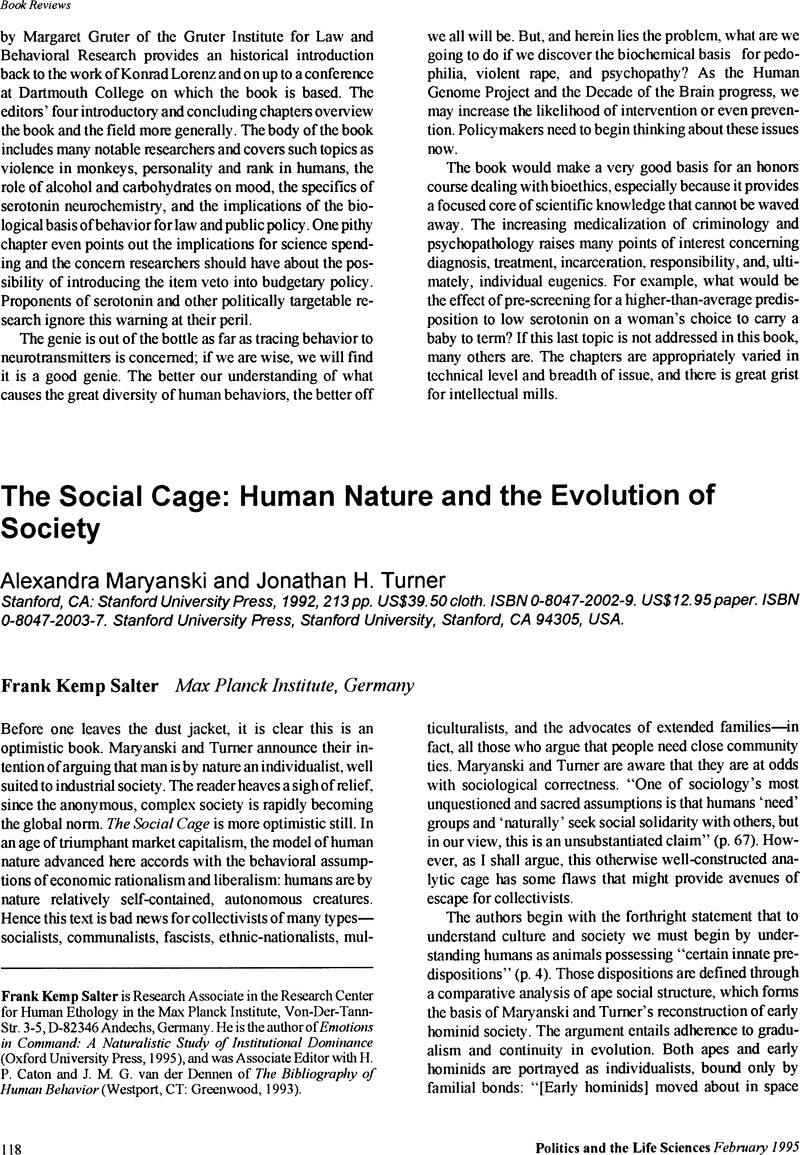No CrossRef data available.
Article contents
The Social Cage: Human Nature and the Evolution of Society. Alexandra Maryanski, Jonathan H. Turner, Stanford, CA:Stanford University Press,1992, 213 pp. US$39.50 cloth. ISBN 0-8047-2002-9. US$12.95 paper. ISBN 0-8047-2003-7. Stanford University Press, Stanford University, Stanford, CA 94305, USA.
Published online by Cambridge University Press: 17 May 2016
Abstract
An abstract is not available for this content so a preview has been provided. Please use the Get access link above for information on how to access this content.

- Type
- Book Reviews
- Information
- Copyright
- Copyright © Association for Politics and the Life Sciences
References
Balch, S.H. (1986). “The Neutered Civil Servant': Eunuchs, Celibates, Abductees, and the Maintenance of Organizational Loyalty.” In White, E. and Losco, J., (eds.), Biology and Bureaucracy: Public Administration and Public Policy from the Perspective of Evolutionary, Genetic and Neurobiological Theory. Lanham, MD: University Press of America.Google Scholar
Cashdan, E. (1983). “Territoriality Among Human Foragers: Ecological Models and an Application to Four Bushman Groups.” Current Anthropology 24:47–66.Google Scholar
Cashdan, E. (1989). “Hunters and Gatherers: Economic Behavior in Bands.” In Plattner, S., (ed.), Economic Anthropology. Stanford, CA: Stanford University Press.Google Scholar
Caton, H.P. (1988). The Politics of Progress: The Origins and Development of the Commercial Republic, 1600-1835. Gainesville, FL: University of Florida Press.Google Scholar
Darwin, C. (1874). The Descent of Man and Selection in Relation to Sex. London: Murray.Google Scholar
Eibl-Eibesfeldt, I. (1972). Love and Hate: The Natural History of Behavior Patterns. Translated byStrachan, G.. New York: Holt, Rinehart and Winston.Google Scholar
Eibl-Eibesfeldt, I. (1979). The Biology of Peace and War: Men, Animals, and Aggression. Translated byMosbacher, E.. London: Thames and Hudson.Google Scholar
Geiger, G. (1988). “On the Evolutionary Origins and Function of Political Power.” Journal of Social and Biological Structures 11:235–50.Google Scholar
Konner, M. and Shostak, M. (1986). “Ethnographic Romanticism and the Idea of Human Nature: Parallels between Samoa and !Kung San.” In Biesele, M., Gordon, R., and Lee, R., (eds.), The Past and Future of !Kung Ethnography. Hamburg: Buske.Google Scholar
Peterson, N. (1975). “Hunter-Gatherer Territoriality: The Perspective from Australia.” American Anthropologist 77:53–68.Google Scholar
Reynolds, V. (1973). “Ethology of Social Change.” In Renfrew, C., (ed.), The Explanation of Cultural Change: Models in Prehistory. London: Duckworth.Google Scholar
Salter, F.K. (1995). Emotions in Command: A Naturalistic Study of Institutional Dominance. Oxford: Oxford University Press. In press.Google Scholar
Wiessner, P. (1981). “Measuring the Impact of Social Ties on Nutritional Status among the !Kung San.” Social Science Information 20:641–78.Google Scholar




